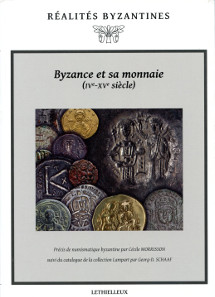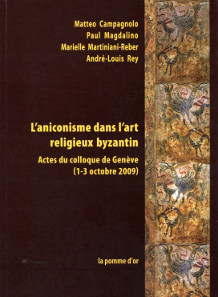by Ursula Kampmann
translated by Annika Backe
October 8, 2015 – Byzantine numismatics is a something for keen specialists. To begin with, if you want to really delve into the subject you must not limit yourself to reading only those works that are written in English, let alone German. By tradition, French is a highly important language in Byzantine studies as well. And so the two books we would like to introduce you here are likewise written in French.
Cécile Morrisson, Byzance et sa monnaie (Ive-XVe siècle), Précis de numismatique byzantine suivi du catalogue de la collection Lampart par Georg-D. Schaaf. Éditions Lethielleux, Paris 2015. 230 pages, black and white illustrations throughout. 17.5 x 25 cm. Paperback. Thread stitching. ISBN 978-2-249-62312-7. 32 euros.
The first book has been written by the Grande Dame of Byzantine numismatics, Cécile Morrisson. It is nothing less than a précis. For all those who have a basic vocabulary consisting of what they need to read a French menu: A précis is a handbook that summarizes what is the most essential of an academic discipline in a minimal amount of space.
As a matter of fact, 100 pages are enough for Cécile Morrisson to masterfully deal with the coinage of an entire millennium. Beginning with minting technology and its changes over time and giving an overview of metrology, she arrives at the several denominations of the rulers. A large part of her work focuses on the coins’ imagery and their interpretation, and finally addresses the question whether or not the users of the coins could actually understand them in the first place.
The focus shifts away from the coins in the next question that tackles the issue of the extent to which coins were used as a means of imperial finance. Morrisson not only deals with the question of the individual mints but likewise traces the denominations’ losses in both weight and fineness. The circulation, both national and international, of the coins is a topic that is also dealt with here.
Cécile Morrisson provides the reader with a smart text that far exceeds anything that can be found in a usual collectors’ compendium. It raises the awareness of the fact that numismatics is much more than a nice catalog with a short introduction.
Speaking of catalogs: The Swiss city of Fribourg is the home of the collection of Albert Lampart (1928-2003). After studying at the Pontificio Istituto Orientale in Rome between 1958 and 1962 and obtaining a doctoral degree (Dr theol), Albert Lampart served as a priest. It was most likely during his time in Rome that he became infatuated with Byzantine numismatics, which, in the end, brought the department for Early Christian and Byzantine numismatics in Fribourg an interesting collection of Byzantine coins, of which the catalog has been prepared by Georg-D. Schaaf for the very same book. Apart from 108 Byzantine coins, the catalog likewise comprises some non-Byzantine specimens, making a marvelous illustration of the handbook written by author Cécile Morrisson (though the quality of some of the images could be a little bit better).
Matteo Campagnolo, Paul Magdalino, Marielle Martiniani-Reber, André-Louis Rey, L’aniconisme dans l’art religieux byzantin. Actes du colloque de Genève (1-3 octobre 2009). La pomme d’or Publishing, Geneva 2014. 230 pages + 70 pages wihout pagination, 115 color plates. Paperback. (Poor) adhesive binding. ISBN 978-2-8306-0257-9. 42 CHF.
Now, we are turning to a perfect addition to the concise handbook: colloquium proceedings published by Matteo Campagnolo, Paul Magdalino, Marielle Martiniani-Reber, and André-Louis Rey. The colloquium in 2009 focused on “Aniconism in the religious art of Byzantium”. 20 distinguished researchers have contributed with articles (of which eight are not written in French but in English).
All contributions revolve around aniconism. We would like to highlight at least those articles that deal with numismatic material. In her fundamental article “The religious significance of Byzantine aniconism”, Marie-France Auzépy also takes coins into consideration. Maria Campagnolo-Pothitou, on the other hand, looks at seals in her article „Like the musty odor of early 12th-century iconoclasm: the testimony of the seals“. And Matteo Campagnolo has given his article the provocative title: “Was there anything as an iconoclastic coin?” He summarizes the coins from the relevant period and investigates their relation to the ban on images.
As you see, Byzantium is a fascinating subject-matter even if you have to brush up your school knowledge in French!
You can order the handbook written by Cécile Morrisson here. It is likewise available as an eBook.
And for purchasing the proceedings of the colloquium please click here.






